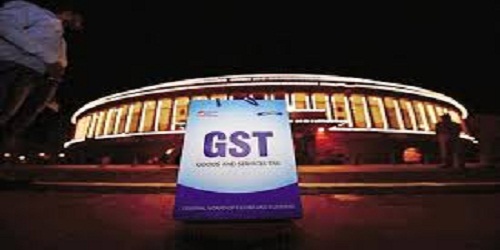GST Council approved a four-tier GST tax structure of 5%, 12%, 18% and 28%, with lower rates for essential items and the highest for luxury and de-merits goods that would also attract an additional cess.
About GST :
Goods and Services Tax (GST) is a proposed system of indirect taxation in India merging most of the existing taxes into single system of taxation.
- “Goods and Services Tax” would be a comprehensive indirect tax on manufacture, sale and consumption of goods and services throughout India, to replace taxes levied by the central and state
- Goods and Services Tax would be levied and collected at each stage of sale or purchase of goods or services based on the input tax credit method. This method allows GST-registered businesses to claim tax credit to the value of GST they paid on purchase of goods or services as part of their normal commercial activity.
- Taxable goods and services are not distinguished from one another and are taxed at a single rate in a supply chain till the goods or services reach the consumer.
- Administrative responsibility would generally rest with a single authority to levy tax on goods and services.

- Exports would be zero-rated and imports would be levied the same taxes as domestic goods and services adhering to the destination principle.
- The introduction of Goods and Services Tax (GST) would be a significant step in the reform of indirect taxation in India. Amalgamating several Central and State taxes into a single tax would mitigate cascading or double taxation, facilitating a common national market. The simplicity of the tax should lead to easier administration and enforcement.
- From the consumer point of view, the biggest advantage would be in terms of a reduction in the overall tax burden on goods, which is currently estimated at 25%-30%,free movement of goods from one state to another without stopping at state borders for hours for payment of state tax or entry tax and reduction in paperwork to a large extent.
- What changes there would be if India launches GST- “The tax rate under GST may be nominal or zero rated for the time being.
- It has been proposed to insulate the revenues of the States from the impact of GST, with the expectation that in due course, GST will be levied on petroleum and petroleum products.”
- The central government has assured states of compensation for any revenue losses incurred by them from the date of introduction of GST for a period of five years.
- India aims to implement GST from 1 April 2017, but this will be contingent on both sides finalizing the design of GST, including the supporting legislation, in the next few weeks.
About the Tax Slabs :
The lowest rate of 5% would be for common use items while there would be two standard rates of 12% and 18% under the Goods and Services Tax (GST) regime targetted to be rolled out from April 1, 2017.
- The highest tax slab will be applicable to items which are currently taxed at 30-31% (excise duty plus VAT).
- As per the rate structure agreed upon by the council, a zero tax rate will apply to 50% of the items present in the consumer price index basket, including foodgrains such as rice and wheat.
- The next tax slab will be 5%, wherein items of mass consumption like spices, tea and mustard oil will be taxed. There will be two standard rates of 12% and 18% where a majority of the items used by the common man will be taxed.
- There will be a higher slab of 28% where items currently attracting a tax of 27-31% will be taxed. However, items used by the middle class such as toothpastes, soaps and refrigerators, which currently have a high tax incidence of more than 27%, will be brought down into the lower slab of 18%.
- The cess will be levied in such a manner that the final tax incidence on such demerit items is not less than the existing tax rates.
- This cess amount, along with the proceeds of the clean energy cess, will be used to compensate states for losses arising from GST, estimated at Rs.50,000 crore in the first year.
- This cess will have a sunset clause of five years.
- It is noted that the states and the centre are also working on a similar tax structure for services, with most services being taxed at 18% and a few essential services at 12% and 5%.
AffairsCloud Recommends Oliveboard Mock Test
AffairsCloud Ebook - Support Us to Grow
Govt Jobs by Category
Bank Jobs Notification





